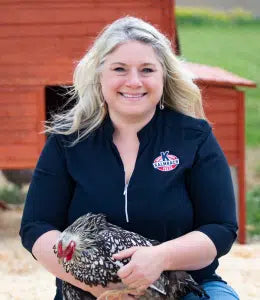What to Consider Before Raising Chicks

The season is upon us. While my gardening friends are all flipping through their seed catalogs, I am studying hatchery websites and excitedly waiting to hear the loud peeps of new chicks as they arrive at my local farm store! Whether you intend to purchase from a hatchery, incubate, or let your broody mommas do the work, spring is the most popular season for new baby chicks.
How Long Do Chickens Live?
Chickens can be a long-term commitment. One of the first things that you should do when getting chicks is to check your local laws and ordinances. Some cities and suburban areas will not allow livestock, but do have exemptions for small flocks of chickens. You also want to check your noise ordinance. Some places may specifically ban roosters. If you have determined that you can have chickens, what can you expect? The natural lifespan of a chicken is about 6-8 years. However, it isn’t unheard of for some chickens to live 10 years or more!
Types of Chicks
If you decide to purchase new chicks this year, it is very important to choose the right type of chicks for your goals. There are a lot of options available. The vast majority of people getting new chicks are looking for future laying hens. Make sure you read the descriptions and signs when choosing your chicks. Look for breeds that are commonly used as laying hens. You also want to choose chicks that are already sorted by sex. Make sure you choose from the groups marked “pullets” or “females.” If you see the terms “mixed sex” or “straight run,” those are going to be groups with both males and females. If you’re interested in egg production, you want females in your flock!
Choosing (or Avoiding) Meat Birds
Spring is also a very popular time to raise meat birds. Most meat bird chicks are going to be sold as straight-run. This means that you will have both males and females in the group. Since most meat birds are harvested before reaching sexual maturity, sorting the males from the females is not necessary. It is very important to stress that you should only choose meat birds or common meat bird strains (e.g., Cornish Cross) if you actually intend to harvest those birds. Meat birds grow very fast and get too big if they are not harvested at an appropriate time.
What Do I Need in a Brooder Box for Chicks?
Now that you have decided what types of chicks to buy, you want to set up your brooder box. Ideally, you want to complete this step BEFORE you get your chicks, so the temperature is correct for the new babies. A brooder box is essentially the nursery for the chicks. Livestock water troughs, large Rubbermaid containers, and even old Pack ‘N Plays are commonly used to make brooder boxes. Brooder boxes should be located in a secure area away from other animals. When I can house my adult birds somewhere else, I will set up my brooder box inside my chicken coop. A workshop or a secure room in a barn or garage are also excellent places to brood. A brooder box needs five essential elements –- Bedding
- A heat source
- A waterer
- A high-quality chick starter feed
- A thermometer to monitor the temperature
How Do I Choose the Right Chick Feed?
Look for a feed that is tailored to the nutrients needs of your chicks. If you chose chicks that will be future laying hens, our Kalmbach 18% Start Right Chick feed is the perfect feed for you. For a more in-depth review of how to choose the right feed for your chicks, check out our articles on How to Feed Chicks and How to Feed Ducklings.
Where Should I Put My Chicken Coop?
Now that you have made the important decision to get chicks, you can start thinking about the fun stuff. Where should I put my coop? My advice – somewhere you can see the birds out a window! Chickens are wonderful entertainment, and it is so relaxing to watch them go about their day. Chicks should be ready to move out of the brooder box and into their coop at about 3-6 weeks of age, depending on the breed. You want to put your coop somewhere safe and near a readily-accessible water source. You may not think of it now but having your coop near a frost-free spigot or a water hose will be SO HELPFUL when you are filling up waterers in the summer and fighting frozen waterers in the winter. You also want to make sure your coop is in a secure location away from predators. Avoid tucking the coop along your tree line or in the woods. Aerial predators will roost in trees and ground predators will take cover in the woods just waiting for an opportunity to attack. Pulling that coop away from the trees will force predators to come out in the open and that can help deter predation.
